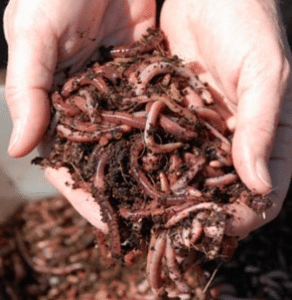
 The scientific name for our amazing compost worms is Eisenia fetida, but we like to call them by their more common name: Red Wiggler. These reddish-brown worms can consume their weight in organic materials each day, turning out castings (or poop) that contain a multitude of good stuff for plants. It’s a practice called vermicomposting and it’s how we produce our incredible products.
The scientific name for our amazing compost worms is Eisenia fetida, but we like to call them by their more common name: Red Wiggler. These reddish-brown worms can consume their weight in organic materials each day, turning out castings (or poop) that contain a multitude of good stuff for plants. It’s a practice called vermicomposting and it’s how we produce our incredible products.
Vermicompost is a nutrient-rich soil amendment that is terrific for all plants. It’s shelf-stable and CDFA Organic certified. Studies have shown it results in larger yields, greater drought tolerance, healthier plants, better root zones, fewer pests/diseases and better soil that’s filled with microbial communities. That last benefit is pretty significant. Worm poop is unique in that it attracts other living organisms that actually improve soil composition over time. Pretty cool, don’t you think?
Red Wigglers are nocturnal and like dark conditions. While they don’t have eyes, they do have sensors that can help them detect light and in natural environments, they stay deep underground in soil during the day so they don’t dry out. (At our facility, we create optimal conditions for our worms 24/7 so they stay happy and healthy.) Red Wigglers live between one to five years. There are no male or female worms — they all can lay egg cocoons that hatch into baby worms. Adults can reach one to five inches in length.
Red Wigglers aren’t picky — they eat just about anything that’s not meat. Ours are fed a mix of silage from corn, hay, and alfalfa and specially prepared manure from Coyne Farm, a New York State Dairy of Distinction that closely monitors the feed and health of all their cattle.
Our worms hang out in digester beds that are 200 feet long and hold between 18 inches and 24 inches of material. Each bed contains 8 million Red Wigglers! The worms, working 24/7, gobble up our specially prepared compost mix and push out their castings. We closely monitor the moisture and temperature of the beds to ensure that the worms are healthy and eating and working as efficiently as possible. Each week, we add about 1.5 inches of new feed material for the worms on the top of the beds and we scrape off about 1.5 inches of pure solid worm castings. In case you’re wondering, it takes about three months from the time the compost mix is added to the worm digester beds to the time the vermicompost is harvested at the bottom.
Harness the power of Red Wigglers at your home or business! Whether you’re a backyard gardener or run a commercial growing operation, our vermicompost can help make your efforts more successful. Learn more about us: http://www.wormpower.net/